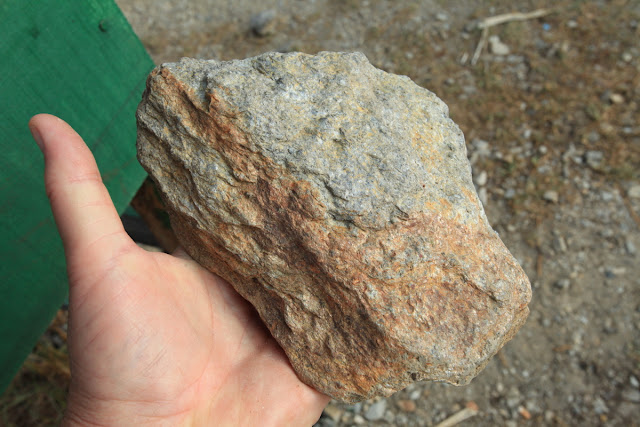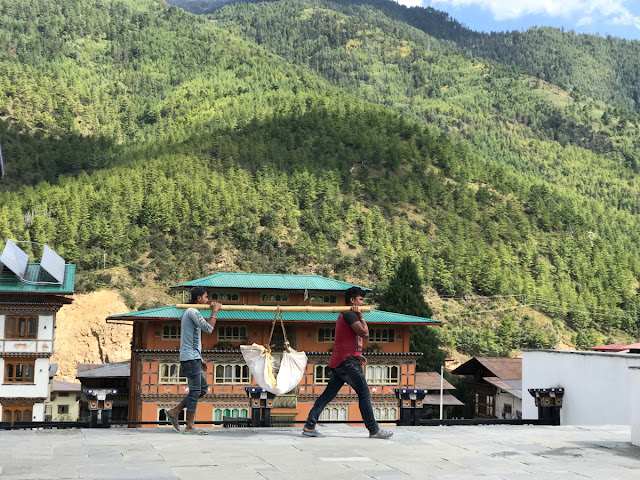Bhutan is an Eastern Himalayan Kingdom surrounded by India and China. Think about that for a moment when you consider that the country only has 760,000 citizens. It was a closed to all outsiders until 1971 and television and the internet were only introduced in 1999. You readily notice how this influences a visit to the country today. There is no private touring in Bhutan - everyone must be on an organized tour with a guide (except for Indian nationals who were recently granted visiting privileges without a guide). It's an un usual and mountainous country.
The Four Pillars of Gross National Happiness in Bhutan. In 1972, King Wangchuck instituted a measurement known as Gross National Happiness, whereby the purpose of the political state was to insure a level of contentment for all citizens.
The national flag can be seen painted on the winglets.
The flight into Paro (the only international airport) is an adventure and only a few pilots with the national airline (Druk Air) are licensed to fly into it. Mountains require a sharp S-turn in some conditions.
Literally, everywhere I went in Nepal and Bhutan, the sidewalks were paved in cut slabs of muscovite schist. It was astounding that this stone was used along such a wide margin of the Himalayan front.
Here is a close-up of a hand sample along a road cut. These rocks were altered from shale that was deposited in the Proto-Tethys Ocean, in existence from about 700 to 500 Ma. The metamorphism occurred along the thrust faults that underlie the mountains.
Our first stop was Thimpu, the capital of the county. While visiting the Textile Museum, I saw these two workers carrying a load of dirt to a construction site. This technique was observed elsewhere and although I did see a few bulldozers, muck of the labor is still done by hand.
Bhutan was inhabited as early as 2000 BCE, and the modern history begins in the 7th century when people came over the Himalaya from Tibet and introduced Buddhism. (A structure in Paro remains from this time period of settlement). Numerous fortresses/monasateries called Dzongs dot the countryside and the one seen above sits in the Thimpu Valley.
The Thimpu Dzong at night is a beautiful sight.
A giant Buddha statue has been built on Thimpu's southern hillside. We were able to enter the temple that sits beneath the statue.
Monks at the Buddha statue.
The Buddha and clouds.
This is a view to the north of the Thimpu Valley. The High Himalaya are hidden by clouds but the mountainous nature of the landscape is evident.
After leaving Thimpu we drove east on the East West Road, which took us over Dochula Pass, elevation 10,171 feet. Here there are 108 memorial chortens or stupas that overlook the highway.
Unfortunately, the clouds covered the High Himalaya and we could not see the glaciated peaks in the distance. However, the large cypress trees in this protected area were fabulous to see. As I have observed in Nepal, the peaks are what your eye sees readily but the depth of the cvalleys is no less astounding. A hint of that can be observed in this photograph.
Our local guide, Dorji, prepares the prayer flags that we will hang across the East West Road. This location is one he uses only for the Smithsonian trips.
Our driver, Sonam, takes the string across the road...
...and climbs the road cut across the way...
...to a tree that looked to be too young and too dead to hold him - to make the final attachment. Honestly, this feat was amazing to watch as he was dressed in what looked like inappropriate shoes for climbing loose soil and dead trees! But Sonam was in the equivalent of our Green Berets and as such is used to doing death defying feats. It was amazing to watch.
As we entered the valley of Punakha, I made a friend at a local temple site. Rather, she made a friend as she was the one to come over from where her mom was selling crafts and just sat on my lap.
The journey included a rafting trip on the Mo River, the mother river in the native tongue.
We ran about 15 kilometers on the Class II stretch. Water rom the Himalaya!
A wonderful lunch was prepared for us riverside after the trip.
This beautiful Dzong is also located on the Mo River.
This is the covered bridge leading to the Dzong.
And a view from inside the covered bridge.
The artwork inside the Dzong is fabulous and reflects Himalayan themes. Note the snow-capped peaks in these two paintings.
Hallway in the Dzong.
Courtyard.
I'm pretty sure a grandmother is carrying her grandchild while the great grandmother looks on.
Another view. Bhutan is off the path well-traveled but if you have the resources it is well worth the effort.































No comments:
Post a Comment
If your comment will not post, email me with the problem.